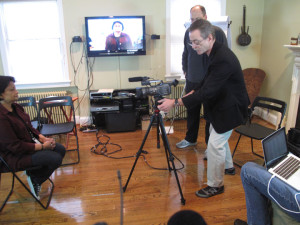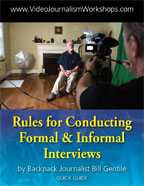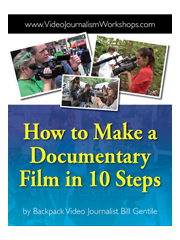Learn how to set up and conduct a formal sit down interview in Video #8 of the Video Journalism Workshop.
In the previous post we looked at informal interviews. In this email we highlight the rules for conducting a formal interview.
The formal or sit-down interview is the classic situation if which you set the camera on a tripod, have some control over the lighting and ask a series of (mostly) prepared questions.
Conducting a formal interview is covered extensively in Video 8 of the ONLINE Video Journalism Workshop course on making compelling documentaries.
The FORMAL interview is much more focused and planned. Following the rules below should give you some great material for your documentary and real insights into your subject.
- Where’s the light? This is the first thing you establish upon beginning a formal, sit-down interview. How you shoot the interview is almost totally contingent on the source of light.
- Make your subject look into the light, and into compositional space.
- Make eye contact.
- Get subject to introduce him/herself.
- One-on-One interviews.
- Two-on-One interviews. (you and a correspondent or producer).
- Get subject to speak in whole sentences. The audience (normally) will hear only the answers, not the questions.

Shot from the Video Class on how to set up a formal interview. Walks your through the set up, lighting, questions to ask and how to set up your camera.
- Composition and focus.
- Careful with background. (depth of field).
- Get clean sound.
- Save the hard questions for LAST.
- Get written releases FIRST.
- Get on-camera releases if you cant get written releases.
- Your last questions:
- Is there anything I missed that I should be asking you?
- What are your greatest hopes and concerns in relation to the subject matter?
- In either informal or formal interviews, know what you want from the subject BEFORE you engage.
- NEVER, NEVER SHOW YOUR SUBJECT THE UNFINISHED WORK.
Download our PDF book on Conducting Formal_and_Informal_Interviews.pdf
To read our post about the rules for informal interviews Click Here
Thank you for visiting our site and hope these lessons on making video documentaries are helpful. We would love to hear your feedback and questions. If you would like to receive emails like this and our free pdf book Tip, Tools and Resources for Making Documentaries please subscribe in the upper right corner.
About the ONLINE Video Journalism Workshop Course?
Discover the secrets of creating powerful video documentaries in the ONLINE Video Journalism Workshop course. You’ll enjoy an intensive 14-part immersion in the craft of learning how to make documentaries.
The course on making video documentaries covers the gamut of the storytelling craft from the genesis and shaping of story ideas, to shooting powerful images that drive the story, to capturing and using sound. You learn about script writing, narration, and editing with portable computers and modern editing software. Please visit the Video Journalism Workshop home page for more details.
Connect with us on Facebook at ?https://www.facebook.com/VideoJournalismWorkshops


